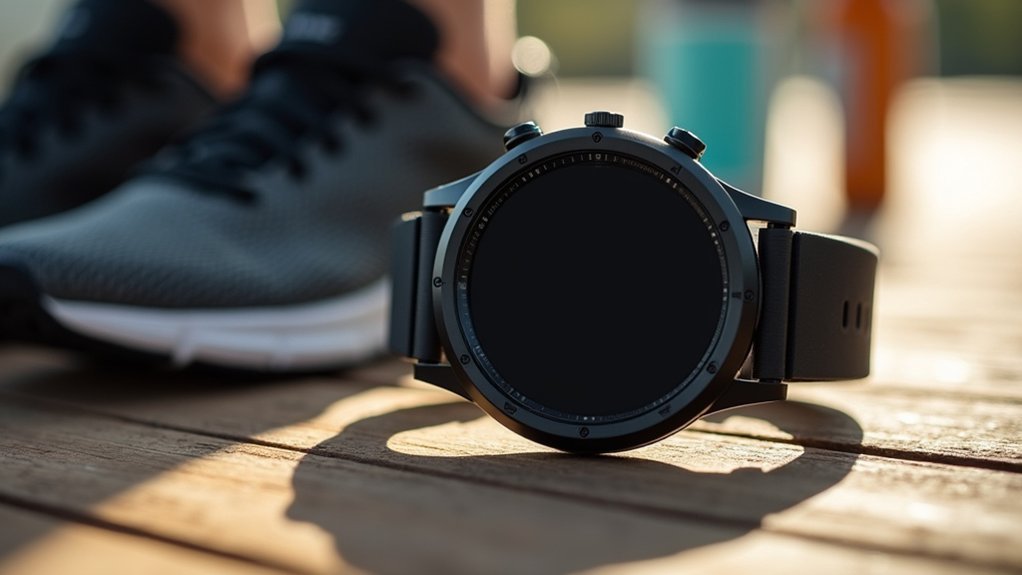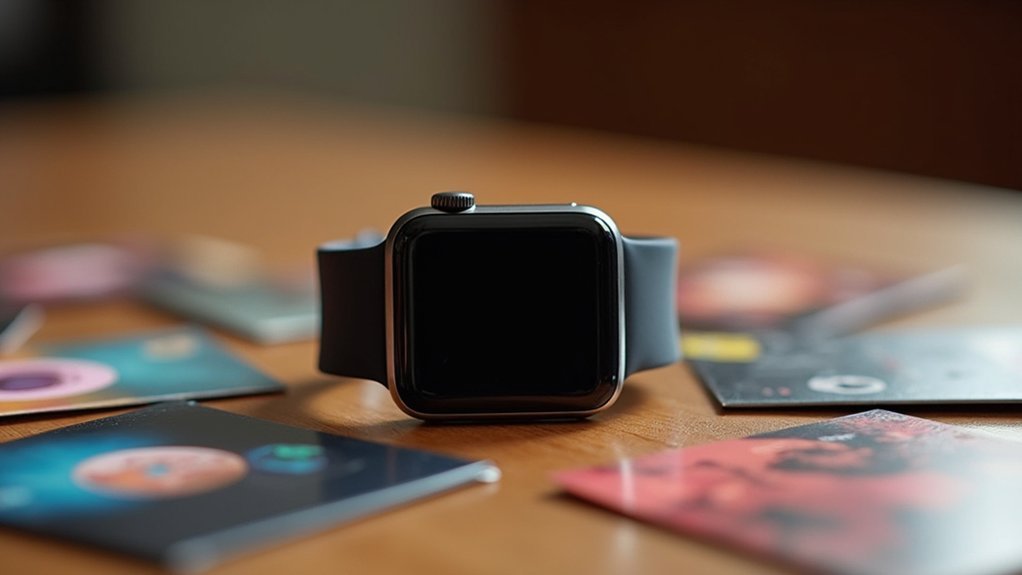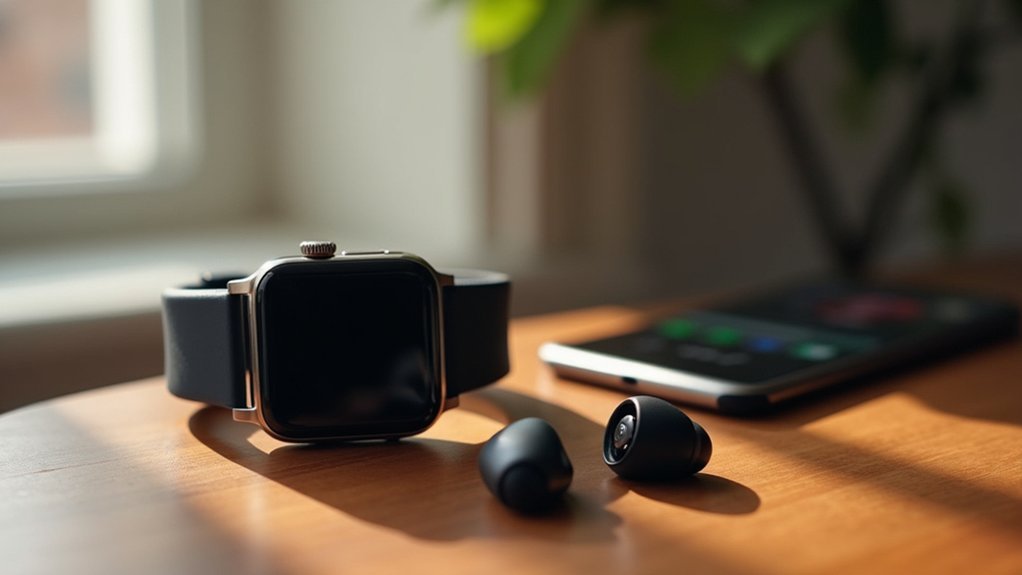When choosing a triathlon heart rate watch, prioritize accuracy by selecting chest straps for intense training and optical sensors for casual workouts. Consider battery life based on your event duration, with options ranging from 16-73 hours. Guarantee water resistance of at least 5 ATM for swim segments. Focus on devices that track essential metrics like heart rate zones, FTP, and TSS. Select watches compatible with both Bluetooth and ANT+ for seamless integration. These five factors will transform your training effectiveness.
Optical vs. Chest Strap Heart Rate Accuracy for Triathletes

When it comes to heart rate monitoring for triathletes, the debate between optical sensors and chest straps centers on accuracy versus convenience.
Chest straps like the Polar H7 deliver superior accuracy, particularly during high-intensity workouts, with ECG agreement levels reaching 98%.
Research confirms chest straps remain the gold standard, with devices like the Polar H7 achieving nearly perfect ECG agreement during intense training sessions.
Your optical wrist monitors will struggle during activities with significant motion—precisely what you’ll experience in triathlons.
While devices like the Apple Watch offer respectable accuracy (96% ECG agreement), all optical sensors lose precision as your intensity increases, especially when running at faster paces.
Consider your specific needs: If you’re training based on precise heart rate zones, invest in a chest strap.
For general trends and everyday monitoring, optical sensors provide sufficient data while offering greater comfort during long endurance events.
Garmin Forerunner models offer excellent reliability and accuracy while providing comprehensive performance metrics that serious triathletes need.
Critical Battery Life Factors for Multi-Sport Events
Endurance stands as the cornerstone of both triathlon racing and the devices designed to track your performance. When selecting a triathlon watch, battery life can make or break your race experience.
Consider your event duration first—the Garmin Fenix 7 Solar’s 73-hour GPS capability serves ultratriathletes well, while the Forerunner 745’s 16 hours suits shorter races.
Solar charging provides considerable advantages for multi-day events, with efficiency varying based on sunlight exposure.
To maximize battery during competitions, fully charge pre-race, utilize power-saving modes during less critical segments, reduce screen brightness, and minimize data syncing.
GPS signal strength, heart rate monitoring frequency, and screen settings all impact battery drain considerably.
For longer events, consider watches like the Coros Pace 3 (38 hours) or pack a portable charger for emergency power. The Garmin Enduro 3 offers exceptional longevity with its 320 hours claimed battery life, making it ideal for ultra-distance triathletes.
Water Resistance Ratings for Swim Segments

Water resistance ranks among the most critical features for any heart rate watch you’ll use during triathlon swim segments. Understanding ATM ratings will guarantee your device survives the aquatic portion of your race.
| Device | Rating | Best For | Material | Special Features |
|---|---|---|---|---|
| Standard HRMs | 3 ATM | Light exposure | Textile | Basic protection |
| Garmin HRM-Swim | 5+ ATM | Pool swimming | Sticky silicone | Prevents slippage |
| Garmin HRM-Tri | 5+ ATM | All disciplines | Lightweight | Multi-sport tracking |
| Polar H10 | 5+ ATM | Accuracy focus | Textile with silicone | 400hr battery life |
| Polar OH1+ | 5+ ATM | Comfort | Armband design | Standalone operation |
While manufacturers often provide conservative ratings, don’t risk your investment. For dedicated triathletes, devices specifically designed for swimming like the HRM-Swim or Polar H10 offer superior performance during water segments. Hands-on testing has consistently shown that real-world usability during swim sessions is best evaluated through comprehensive assessment rather than specifications alone.
Training Metrics That Actually Matter for Race Day
Beyond waterproof features, your triathlon success hinges on monitoring the right data points. Focus on heart rate zones and lactate threshold heart rate (LTHR) to properly gauge your effort during both training and racing.
Power output is vital for cyclists, with Functional Threshold Power (FTP) serving as your intensity baseline. Track your Training Stress Score (TSS) to guarantee workouts properly simulate race day demands. Proper pacing helps prevent hitting the wall during your race, allowing you to maintain energy throughout all segments.
Don’t overlook Form (TSB), which indicates your readiness for peak performance. Aim for a value between -5 to +25 on race day.
The Variability Index helps maintain consistent pacing—essential for triathlon success.
When selecting a watch, prioritize devices that track these metrics rather than those offering countless features you’ll never use during competition.
Sensor Compatibility and Data Integration Features

While analyzing your triathlon watch options, sensor compatibility should top your priority list. Look for watches that support both Bluetooth and ANT+ to guarantee seamless integration with smartphones, tablets, and other training devices.
The best options can connect to multiple devices simultaneously, giving you flexibility during training sessions.
Consider how the watch integrates with your preferred apps and equipment. Leading models sync with platforms like Zwift, Wahoo, and specialized training apps for thorough analysis.
Polar devices work with iOS 13+ and Android 7+ with Bluetooth 4.0 capabilities.
For accurate performance tracking, prioritize watches with ECG-based technology over optical sensors when possible, as research shows chest straps outperform wrist-based monitors in measurement accuracy.
Most quality options offer real-time heart rate data, waterproofing, and long battery life—essential features for the demanding nature of triathlon training.
Frequently Asked Questions
How Do Altitude Changes Affect Heart Rate Monitoring Accuracy?
At higher altitudes, your heart rate increases due to lower oxygen levels. This can affect monitoring accuracy as devices may struggle to interpret altitude-induced stress, environmental conditions, and physiological adaptations you’re experiencing.
Can I Switch Between Watches for Different Triathlon Distances?
Yes, you can switch watches for different triathlon distances. It’s practical if you guarantee data compatibility, consistent heart rate zones, and allow setup time between events. This approach lets you optimize features for each distance.
Do Triathlon Watches Work With Wetsuit Sleeves?
Yes, triathlon watches work with wetsuits. You’ll get better results wearing your watch under the wetsuit sleeve for comfort and accuracy. This positioning prevents catching while swimming and allows easier access to buttons when needed.
How Often Should I Recalibrate My Watch’s Heart Rate Sensor?
You don’t need to recalibrate your heart rate sensor regularly. Recalibrate only after major changes in your physical condition, software updates, battery replacement, or if you notice inconsistent readings during your workouts.
Will My Watch Transfer Transition Times Automatically Between Sports?
Yes, most modern triathlon watches automatically transfer changeover times between sports. Your Garmin, Apple Watch, or Coros device will track changes with GPS enabled, though you can still manually control timing for greater precision.
In Summary
When choosing your triathlon heart rate watch, you’ll want to prioritize accuracy, battery endurance, and proper water resistance ratings. Don’t get distracted by flashy features—focus on metrics that directly impact your performance. Consider how your watch integrates with other sensors and training platforms. The right watch doesn’t just track your race; it transforms your training and gives you the competitive edge you’re looking for.





Leave a Reply